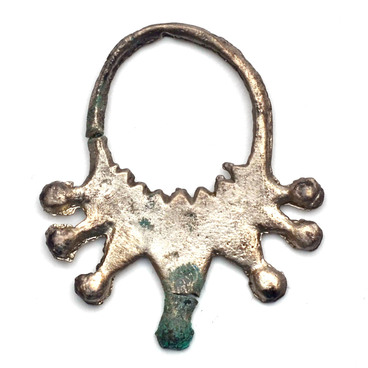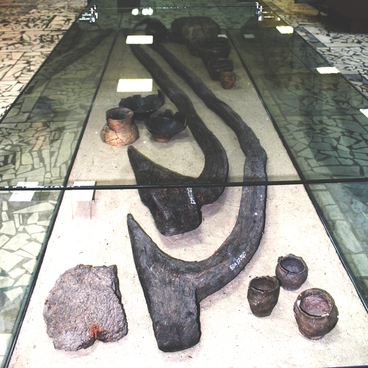Sculptor Nina Kozlova created the girl’s bust sculpture in 1986 using a sports school student Elena Sebekina for a model. The author made it from plaster and put a coat of bronze color tint on its surface.
Girl from the Radimichi Tribe
Время создания
1986
Размер
57x44x27 cm
57х44х27 cm
57х44х27 cm
Техника
Plaster, tinting
Коллекция
Выставка
0
Открыть в приложении#1
Nina Kozlova
Girl from the Radimichi Tribe
#2
#3
The sculpture depicted a young girl from the Radimichi tribe, and judging by the absence of a headdress, an unmarried one. A strap tied around her forehead holds temple rings fixed to it and cascading down on both sides of her face. Her hair is gathered into a knot at the back of her head. The sculptor added two small bead necklaces on the girl’s neck, the most popular piece of jewelry among Slavic women
#4
The Radimichi tribe inhabited the area between the rivers of Dnieper, Desna, and Sozh. Legends say that the tribe’s name comes from the name of its first chieftain, Radim who brought his people to those lands. The Russian Primary Chronicle, Tale of Bygone Years says that
#5
“the Radimichi and Vyatichi are decedents of the Poles. Two polish brothers Radim and Vyatko came in and settled in the area. Radim, the ancestor of the Radimichi settled along the river of Sozh; Vyatko with his kin settled along the river of Oka and started the tribe of Vyatichi”.
The name of Radimichi came up in historical documentation from 885 to 1169.
.
.
#9
The tribe was ruled by chieftains, rather than princes. The same source (The Tale of Bygone Years) says that the Radimichi first lived under the rule of the Khazars, but after 885 began to pay tributes to the Kievan Prince Oleg. In 907, the Radimichi warriors took part in the legendary expedition against Tsargrad, in which Oleg hung his shield in triumph on the gate of the Tzargrad and received a nickname Prophetic.
#10
The tribe settled on fertile land along the rivers. The Radimichi cleared forestland and removed stumps in order to develop land for farming. They cultivated mostly wheat, oats, flax, cabbage, peas, and beetroot. Starting from the 11th century, the Radimichi mastered the two-field system of crop farming: one group of fields was planted while the other group of fields was allowed to lie fallow, i.e. free of planting. The following year, the group of fields left unused would be cultivated. Such a system allowed for bigger harvests than annual field planting.
Radzivill chronicle. List 11, back (885). Source: ru.wikipedia.org
#7
In addition to land farming, the Radimichi were also engaged in cattle breeding: they kept pigs, horned livestock, and domestic fowl. In the surrounding forests, the hunters procured game and fur-bearing animals.
#8
Archeologists are finding ceramic pottery, weapons, and women’s jewelry pieces in the Radimichi burial sites in the Bryansk region. Temple rings with seven projections are most frequent among the finds. The Radimichi women fixed them to their headdresses or used as hair ornaments.
#11
Bryansk State Regional Ethnography Museum, a State budgetary cultural institution
читать дальшескрыть
00:00
00:00
1x
Girl from the Radimichi Tribe
Время создания
1986
Размер
57x44x27 cm
57х44х27 cm
57х44х27 cm
Техника
Plaster, tinting
Коллекция
Выставка
0
Открыть в приложении
Поделиться


